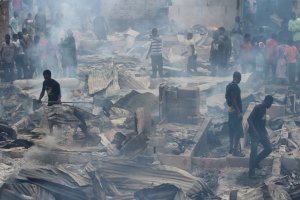It all started in the 1980s when the developed world or well-off people in Europe and America realized that a garbage dump in Africa would be much cheaper than in their own countries. Can you imagine how much the disposal of toxic chemicals in Europe costs in compliance with strict environmental regulations and safety rules?
This is a lot of money and in Africa, with the kind of leaders, porous borders and weak security this can be done for a penny because a changed dollar or a pound fetch a substantial amount of Africa’s weak currency. So from all over the world, giant wastes with hazardous substances and electronic debris were shipped to the “black continent.”
In 1987, an Italian ship dumped a toxic load on Coco Beach in Nigeria, without any compensation, the local residents started to get partial paralysis. As a result, the United Nations banned the import of hazardous wastes from developed countries to developing ones.
However, the United States, Canada, Australia, and New Zealand refused to sign this convention, not to mention the greedy merchants and corrupt officials, who also refused to sign because if signed there wouldn’t be an easy place to dump such dangerous cargoes besides Africa.
As a result of easy penetration and corruption, in the 21st century, the “black continent” remained the main global focus of poverty, disease, dirt, and total social insecurity, vaccine trials, and human experimentation.
In a placed called Agbogbloshi in Ghana, near the capital of Ghana, Accra, it became the world's largest electronic waste cemetery. Every year, about 200,000 tons of electronic waste are brought there from developed countries, from which the local people mine copper and aluminum from morning to evening.
The easiest way to get copper is burning, so the city became polluted with clouds of poisonous smoke. The main labour force is boys from 10 to 18 years. Couples of lead, mercury, and arsenic undermine their health: many do not even live to 30 years.
Nairobi, Kenya The trash monster of Nairobi is not only garbage imported from developed countries, but also the own waste of a metropolis that has grown more than 3 times over a couple of decades. It is a home to 3 million people, and the dump is still one, opened in 1986 and long overflowing.
Every day, trucks dump 1000-1200 tons of garbage. The landfill has more than 3000 men, women, and children who seek out at least some raw materials for recycling, earning the equivalent of 4 dollars per day, while marabou and pigs search for food.
Zabbalin, Egypt The name of this suburb of Cairo and translates the "city of garbage men." Extremely unpleasant smell streets, with full of activities of people in respirators, donkeys with carts laden with garbage. According to the Arabs, the lower class social group, the Coptic Christians, live there.
For several decades, they have been collecting garbage from residents of the capital and taking them to their poor residential areas. The archaic and hazardous system, however, is one of the most efficient in the world: Zabbalin scavengers manage to recycle 85% of waste. Western recycling companies can only dream of such indicators! However, part of the waste in Zabbalin is still burned, seriously polluting the atmosphere of Cairo.
Bamako, Mali Do not take pictures of government buildings, do not walk alone in regions where human sacrifices are made (white people are better suited to appease the gods) and never drink water without additional purification! The golden rules that every true Mali traveler knows. Compared to 1960, the city’s population has grown about 20 times - from 100,000 to 2 million. How should public transport systems, energy, water supply, wastewater treatment, industrial emissions standards develop? For some reason, no one thought about this.
Tiara Sur Sur, Senegal This city is sadly famous in 2014, rankings for the case of massive acute lead poisoning. Local women earned their pennies by manually crushing used lead-acid batteries and melting the lead they mined for resale. Lead fumes and dust filled the city: 18 children died from a rapidly progressive disorder of the nervous system. A study conducted on other members of the community (including brothers, sisters, and mothers of dead children) showed that all of them were also subjected to lead poisoning.
Niamey, Niger In the mid-1980s, the Niger River was very dry, and residents drilled about 120 wells. The city was growing rapidly and the population reached 700,000 people, but the water supply and sewerage systems remained the same, as modern sewage treatment systems weren’t recommended.
Due to uncontrolled economic activities and deforestation, groundwater soon became contaminated with nitrates and bacteria, such as streptococcus. In the rainy season, feces are added to this. The problem of water quality here is more acute than anywhere else on Earth. Today, every fourth child born in the capital of Niger does not live to be 5 years old.
Pretoria, South Africa
South Africa is one of the few African countries with official environmental regulations. But in large cities to control their compliance is very difficult. Pretoria with its three million inhabitants is a real city of contrasts: a modern center with skyscrapers, business centers, and fountains, surrounded by slums in which there is not even electricity.
The locals’ burn coal for heating and cooking and with an addition to the smog from transportation, the industry, and water pollution with estrogen-like chemicals, you will understand why Pretoria’s doctors are sounding the alarm and talking about the risk of cancer.
Maputo, Mozambique
While some are getting richer in recycling waste from the developed countries of the world, others are trying to find at least some means of subsistence in giant dumps. But when CNN journalists arrive at the dump in Maputo, its inhabitants openly demonstrate their position, hospitality, smile widely and are eager to help.
These are men, women, and children who eat leftovers and put on shreds left over from more prosperous members of society. How many hundreds or thousands of people inhabit the 17 hectares landfill? No one knows.
Casablanca, Morocco 0% of Casablanca residents suffer from diseases caused by air pollution: asthma, conjunctivitis, with chronic respiratory problems. In addition, local residents take water from rainwater canals, and they themselves dump slop and garbage into these canals.
Apparently, the proverb about "do not spit in the well" is something they are not aware of. Africa's development is essential because without that we will always be used by the developed world.
Opinions of Friday, 30 November 2018
Columnist: Joel Savage















